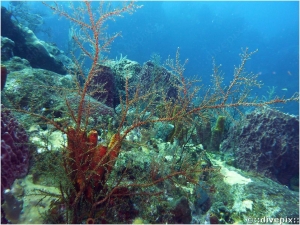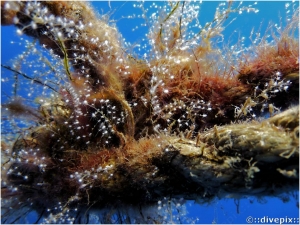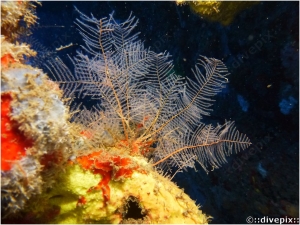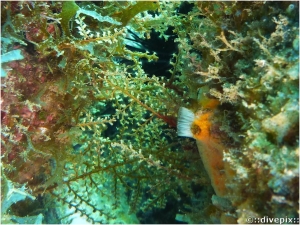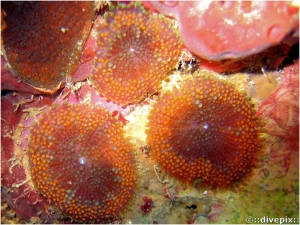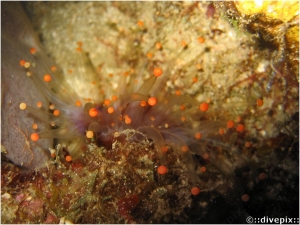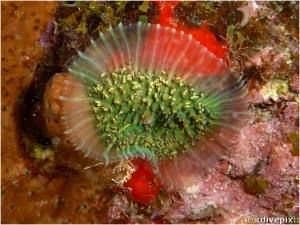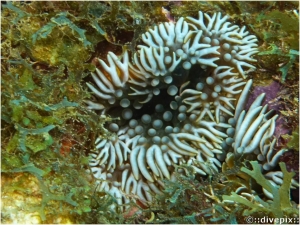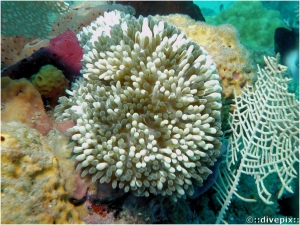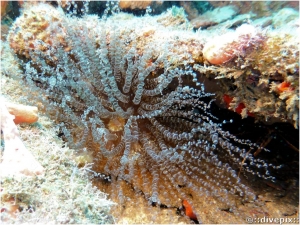




Eric H. Biass
Feather Bush Hydroid
| Aspect: | A scraggly, ungainly structure that generally develops into a bush of main and subranches from which herringbone-like secondary branches grow to bear straight rows of tiny polyps. |
| Population: | Relatively common, but often goes unnoticed. |
| Notable feature: | Main stems and branches are often heavily colonised by zoanthids of various types and colour. |
| Environment: | Open areas with current to catch plankton (but also all maner of other particles that can make the bush look somewhat untidy. |
| Behaviour: | Urticant. |
Branching Hydroid
| Aspect: |
Thin white-tufted parallel branches alternately growing in a single plane on either side of a small brown stem. The white tufts actually are polyps that also extend alternately upwards and downwards from each branch. Taller specimens (about 15cm max), may carry secondary branches. ATTENTION: formerly Sertutella speciosa, now Serturella diaphana |
| Population: | Common, especially on current-swept natural bases or man-made structures, like mooring jetties and shipwrecks which they can generously invade, and particularly around wreck window and doorframes that offer a good flow of plankton-rich currents, but also permanent mooring lines. |
| Notable feature: | The tiny white horn-shaped polyps are home to about 28 hair-thin tentacles in charge of catching plankton. |
| Environment: | See "population" above. |
| Behaviour: | Stings badly, not to be touched. |
Algae hydroid
| Aspect: | Small branches alternately grow in a single plane on either side of a relatively short stem. Polyps on the other hand, grow off the branches symmetrically. |
| Population: | Common in certain areas. |
| Notable feature: | Stem and branches tend to be light brown, polyps are snow white. |
| Environment: | Grow off vertical structures that provide a steady water flow. Shipwreck masts and window frames are popular locations. |
| Behaviour: | - |
Florida Corallimorph
| Aspect: |
More often than not, a corallimorph appears as a circular arrangement of colorful beads that get larger as they progress towards the edge of the disc, although the arrangement can digress from a circular pattern to suit the surrounding topography. A close look reveals that the beads are in fact the tip of short tentacles. As a matter of fact, the corallimorph, as the name implies, is very much an anemone (q.v.) that tries to resemble a coral, with the major difference that it does not secrete any of the calcareous substance the would enable it to build up a skeleton. Unlike a common anemone though, the corallimorph spreads flat over the chosen substrate to form a disc (known as the oral disc) on which tentacles develop radially and concentrically, surrounding a central mouth. |
| Population: | Common. |
| Notable feature: | As the photographs herewith show, all colour combinations appear possible. |
| Environment: | Tends to grow off coral boulders. |
| Behaviour: | Like anemones, uses its toxic tentacles to forward a parlysed prey towards the central mouth. |
Orange Ball Corallimorph
| Aspect: | Stout tubular body the upper edges from which translucent orange ball-tipped tentacles extend to give the appearance of a fireworks. |
| Population: | Occasional. |
| Notable feature: | More usually visible at night. Protruding mouth can be seen in the centre of the relatively flat oral disk, which differientiates it from the anemone. |
| Environment: | Usually on rock and coral boulders. |
| Behaviour: | Will promptly retract if disturbed. |
Warty Corallimorph
| Aspect: | A patch of green to blue warty, fork-tipped tentacles spread over a flattened oral disk, itself surrounded by thinner and taller tentacles connected by a translucent veil. |
| Population: | Occasional. |
| Notable feature: | Can be solitary or in tight groups as exemplified by photos below. |
| Environment: | Live on rocky structures |
| Behaviour: | The ensemble will immediately wrap itslef into the protected translucent veil controlled by the outer tentacles, as seen on one of the photos below. |



